All Saints' Church Restoration
The New Church Roof
All Saints' Church has finally got its new roof after much fundraising. Extensive scaffolding was erected and the old tiles were removed. The roof repairs were due to have started in August 2010 and finished by January 2011, however, there were delays because the contractors were let down by their sub-contractors, and work was so far behind schedule that there was not time to complete the re-tiling of the roof before the bat window closed in mid-November. There had also been a hold-up in proceedings as some of the bats that are known to roost in the roof were still active, and they are a protected species. There are known to be four species of bat in the church roof, including Pipistrelle and Long-eared bats, but due to the warm sunny days of the Autumn of 2010, they were still waking and venturing out! An ecologist was very concerned about bat disturbance, and the work had to stop in mid-November and restarted at the beginning of March 2011. They seem to be very fragile creatures that lose a fatal amount of energy if woken up from their big sleep. Lucky things!
The roof timbers had been inspected by a structural engineer and were thankfully pronounced sound, which meant that there were no extra unforeseen costs. The entire roof of the nave, chancel, transepts and the lower roofs were done. Now the church is watertight for the next few centuries and restoration of the interior of the church can go ahead.
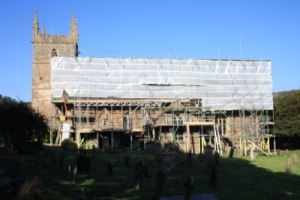
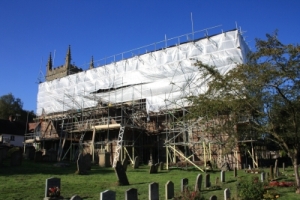
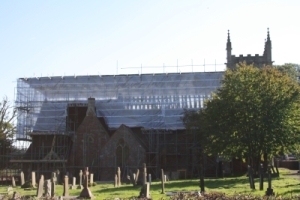
Chancel Restoration
Recently permission was granted for the unused choir stalls in the chancel in the church to be removed and sold off, to make more flexible space in the church for worship and other functions. The whole chancel floor was originally raised by about a foot by the Victorians, using stone rubble and covered with cement and tiles. However, the choir stalls were mounted on floorboards supported on wooden joists and stone pillars standing on the original flagstone floor. It was discovered when these floorboards were removed that some of the original gravestones of people interred in the church vault were revealed. Fortunately for us, a man called Ralph Bigland surveyed the church around 1778. He recorded all the inscriptions of the gravestones inside the church and also the tombs in the churchyard of that time, so we were able to put names to the ones that were found. More on Bigland and the graves below.
It would have been nice to keep one of the better graves displayed to the general public by placing it under glass, but after much deliberation it was decided that even if the funds were available, it wouldn't have been a very practical solution. The restoration work was carried out by Tile Trader (Stroud) Ltd. of Stonehouse. They built a wooden framework over the two pits containing the gravestones and boarded them over (in the hope that one day in the future, the gravestones could possibly be viewed once more and also, so as not to damage the stones themselves.) They then re-tiled the chancel floor in modern tiles, but keeping to the colours of the original floor and the rest of the church, although the sizes were different. The result is now very impressive. New chairs will replace the choir stalls.
 |
 |
 |
| The gravestones unearthed. | The workmen remove the old tiles. | The original holes covered over with plywood. |
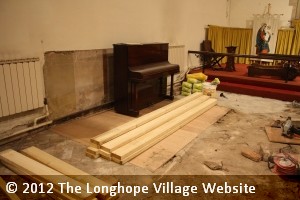 |
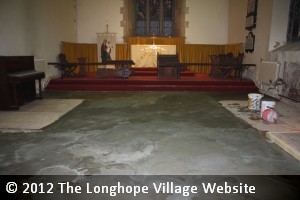 |
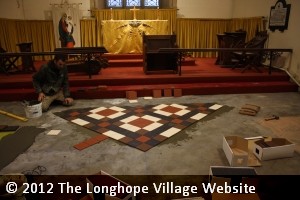 |
| Some serious carpentry taking place! | The floor is prepared for the new tiles. | The start of the tile laying. |
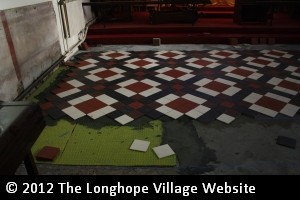 |
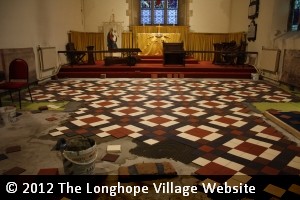 |
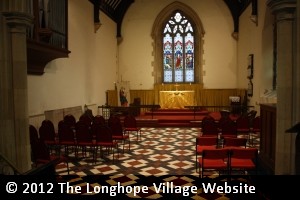 |
| The boards covered with matting before the tiles. | Nearly finished. | Now finished - apart from the walls. |
Bigland
Ralph Bigland was born in Middlesex in 1712, but his family were from the north of England. He was actually a famous cheese maker, but he was also an amateur historian who started to take an interest in the churches of Gloucestershire after he married his wife, Ann, who came from Frocester. He started in 1750 and for the next 30 years, travelled the whole county collecting inscriptions of all the graves in every church, including descriptions of coats of arms and other details of the churches. Bigland, and a few helpers, did all his surveys in his usual methodical manner, in alphabetical order. His intention was to publish his results, but he only managed to get to the letter 'N' before he died in 1784 – which was rather fortunate for Longhope! He is buried in Gloucester Cathedral – a fitting tribute. After his death, his son, Richard, continued his work and tried to get his work published and finally achieved this in two volumes between 1786-1794. Many, if not most, of these memorials are illegible due to weathering, or in Longhope's case, covered over by the Victorian's church remodelling scheme, so we owe a great debt to Bigland for his tireless work. Bigland went on to become the senior herald at The College of Heralds and also given the title Garter Principal King of Arms.
The Yate Family
Nourse Yate was described as a Gentleman and he and his wife Priscilla moved to the village and had six children, one son and five daughters. Nourse Yate was a man of wealth in the late 1600s. He was Lord of the Manor and owner of the largest furnace in the area – originally located behind the church at Court Farm. Surprisingly, he was buried in Hereford Cathedral. We know from Bigland's work that Priscilla, the wife of Nourse, is buried in Longhope chancel from the inscription:
Priscilla, the Wife and Relict of
Nourse Yate, Esq. and Daughter of
Henry Glover, Gent. of Oldswinford,
In the County of Worcester, who died
Jan. 4, Anno Domini 1719-20, aged 61 years.
Nourse Yate's youngest daughter, Frances, was also buried alongside Priscilla Yate (her mother) in 1747, aged 45 years:
Also Frances, youngest Daughter of
Nourse Yate, Esq. by Priscilla his Wife,
died the 28th of June, 1747, aetatis 45.
Their eldest daughter, Mary, was buried in 1761, aged 78 years alongside their fifth daughter, Arethusa, who died in 1752 aged 60 years:
Here resteth the Body of Mary Yate,
eldest Daughter of Nourse Yate, Esq.
Obijt 26 of June, 1761, aetatis 78.
In Memory of Arethusa Yate, 5th Daughter
to Nourse Yate, Esq. by Priscilla his Wife.
Obijt the 10 of April, 1752, aetatis 60.
None of these graves have been seen, but in the pit that was revealed when the choir stalls on the left of the chancel were removed was part of another Yate family grave, that of Charles, their only son, who died in 1729 aged 33 years, alongside their fourth daughter, Henrietta who died in 1752 (although Bigland wrote 1725) seen in the photo below:
Here lyeth the Body of Charles Yate, Esq.
Son of Nourse Yate, Esq. late of this Parish,
deceased, who died the 14 Day of Feb. in the
33rd Year of his Age, Anno Domini 1729.
Also Henrietta, fourth Daughter to
Nourse Yate, Esq. by Priscilla his Wife,
who died March the 9, 1725, aged 60 Years.
Nourse Yate's second daughter, Priscilla Bromwich, was married to the Reverend Lancelot Bromwich (hence the name of their son, Yate Bromwich, who became vicar of Longhope), and was the only one of Nourse's daughters to marry. The coat of arms on the one gravestone that could be seen with a coat of arms, again in the pit on the left of the chancel, was the top half of the grave of Lancelot Bromwich who died in 1752 (a week after Henrietta) aged 72 years, and Priscilla Bromwich who died in 1763 aged 79 years. Their daughter, another Priscilla, describes her mother's death in documents we have, thus: "My dear Mother departed this life after a long & painfull illness – on the 20 of Dec, 5 in the evening, aged 78 years & 11 months 1763" [1]. Bigland's inscription of this grave was:
Here rests, in hopes of a glorious
Resurrection, the Body of
Lancelot Bromwich, Gent.
Obijt 17 of March, 1752, aetatis 72.
Also Priscilla, second daughter to
Nourse Yate, Esq. and Relict of the
Above Lancelot Bromwich, Gent.
Who died December 20, 1763, aged 79.
Bigland describes the coat of arms that we could see as: "Arms, a Lion rampant; - impaling Yate, guttee du sang, for Bromwich" The Yate coat of arms is described as "Arms, in a lozenge, a Fess, in chief, two mullets, for Yate" From our crash-course in heraldic terms we derived the following definitions:
- Impaling is two coats of arms, side by side ie Yate and Bromwich.
- Guttee du sang means drops of blood, which is the speckled background to the arms.
- Fess means a band.
- In chief means along the top edge.
- Mullets are stars, of which there are two (for Yate).
It must be said that this grave had the coat of arms engraved into a very substantial piece of good quality slate! Slate isn't a native of this area, so we must assume that it probably came either from North Wales, Cornwall or Cumbria - the best slate areas of Britain. The question raised is how did they transport such a large piece of slate, perhaps several hundred miles in the mid 1700s? Another point is who did such a wonderful and delicate engraving?
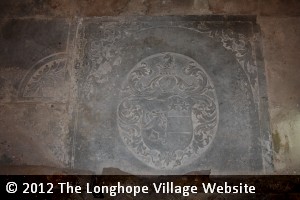 |
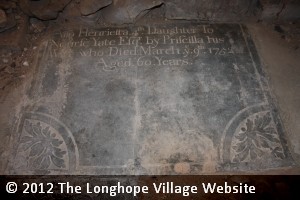 |
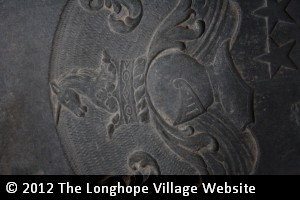 |
| The Bromwich/Yate coat of arms. | The grave of Henrietta Yate. | Admire the delicate engraving. |
Moving over to the pit on the right of the chancel was a very old grave, scribed in latin, but in a very fragile state. It originally had a coat of arms too, and was the grave of Anne Leigh, the wife ot Thomas Leigh, who died in 1677 aged just 27 years:
M.S. Annæ Uxoris Thomæ Leigh,
de Medio Templo Londin, Gen. ex patre
filiae Honorabili Guliemo Cecill, Arm,
filio Guliemi nuper Comitis
Sarisburiensis. Obijt
Anno ætatis 27
salutis 1677.
The other one that was there was post-Bigland and was of Richard Kidson who died in 1808 (as recorded in the burial records).
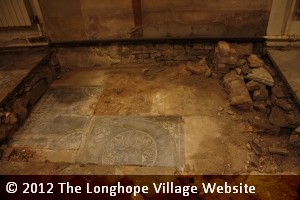
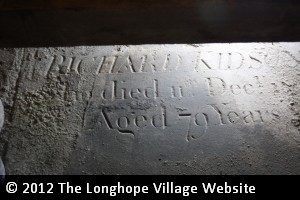
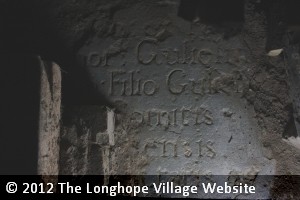
References
- Private documents.